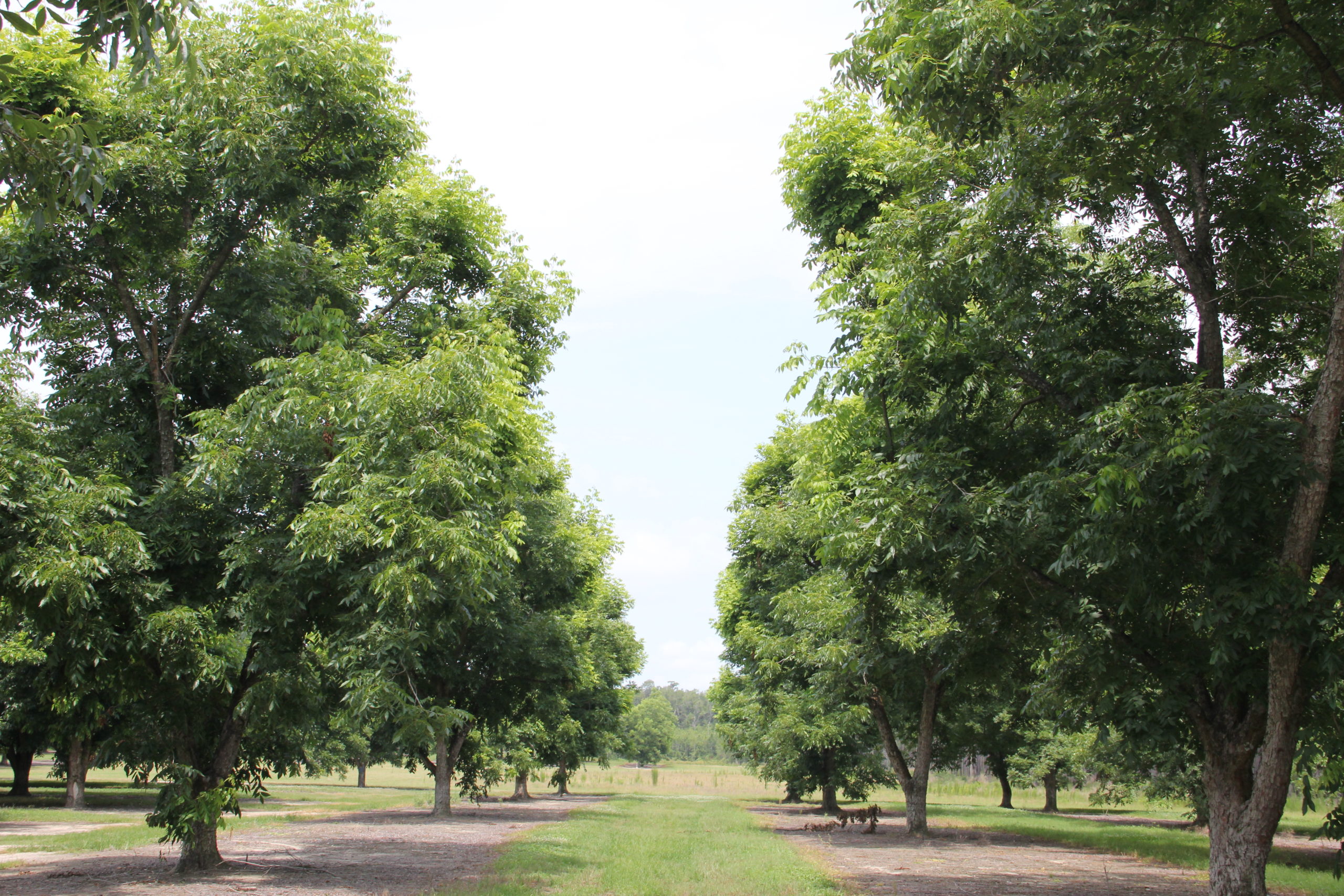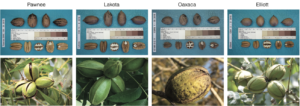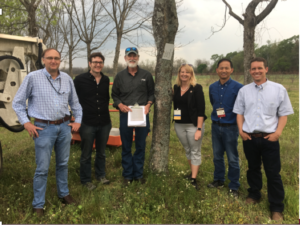Using genomics to improve our future pecan trees

A pecan orchard in the southeastern United States. (Photo by Clive Bock)
Pecan (Carya illinoinensis) is a nut-producing tree native to North America, originally grown in the southern United States and northern Mexico in the region of the Mississippi River. Thanks to both 16th-century Spanish explorers and more recent human-mediated plant transfer, pecan is now cultivated in South America, Europe, Asia, Africa, and Australia. However, the United States remains a leader in pecan production worldwide.
Although pecan is successfully grown across diverse climates ranging from deserts to humid coastal regions, changing climates, pests and pathogens, and increased consumer demand for pecans have begun applying pressure on pecan farmers and threatening to dethrone the United States as a global leader in the pecan industry.

Standardized images of the nuts and nut clusters just before maturity for the four reference pecan genomes. (Photo by USDA ARS)
Sequencing the pecan genome
Pecan trees have a long lifespan and take more than ten years to produce nuts if not grafted to an established rootstock. Consequently, traditional breeding techniques that focus only on traits that are observable at maturity take decades to achieve meaningful crop improvements.
Over the last decade, genome-enabled biotechnologies have been developed that have the potential to accelerate breeding efforts in many crop species. Regions of the genome associated with beneficial traits, called genetic markers, have been successfully employed in breeding programs for many crops to predict whether a mature plant will have a desired trait using the DNA of seedlings. This eliminates the need to wait to see if a trait emerges in a mature plant, thus accelerating the breeding process.
The availability of genome-related resources for pecan could enable the identification of pecan trees with desirable traits within weeks of sampling leaves from young trees. A group of scientists, led by New Mexico State University Professor Jennifer Randall, Ph.D., recently retired USDA horticulturist LJ Grauke, Ph.D., and HudsonAlpha Faculty Investigator Jeremy Schmutz set out to do just that in a project funded through a USDA Specialty Crop Research Initiative (SCRI) grant.
In order for this dream to become a reality, however, scientists needed high-quality reference genomes for pecan to help identify the genetic elements that control various traits. Scientists at the HudsonAlpha Genome Sequencing Center (GSC), led by co-directors Schmutz and Jane Grimwood, Ph.D., contributed their genome sequencing, assembly, and analysis expertise to the project.
“Until recently, genome-enabled breeding relied on mapping sequences to a single reference genome for a species,” says Schmutz. “However, being a long-lived outbred plant, pecan has a tremendous amount of genetic diversity. Using a single reference genome is insufficient to identify desirable gene to trait relationships. We chose to sequence and assemble genomes for four outbred pecan genotypes to represent the genetic diversity of cultivated pecan.”
Genome analysis reveals potential markers for beneficial traits
Analysis of these pecan genomes, led by John Lovell, Ph.D., GSC Evolutionary Analysis Group Leader and lead author of the paper, revealed a complex evolutionary history in pecan. Unlike most industrial domesticated crops, pecan is an obligate outcrosser, meaning pecan trees cannot effectively pollinate themselves and must receive pollen from a different individual. This simple aspect of its biology has shaped both how pecan evolved in nature and how crop breeders can improve cultivars.
“In nature, pecan trees and wild relatives, like bitternut hickory, live close to one another,” says Lovell. “Not unsurprisingly, we see evidence of hybridization between pecan and its wild relatives. However, several pieces of wild relative chromosomes have been maintained within pecan breeding pedigrees. This likely means that movement of genes among species confers beneficial traits to cultivated pecan and gives breeders the diversity necessary to improve pecan for future consumer demands.”
Because of its outcrossing nature, pecan genomes are highly heterozygous, having two, often very different versions of most genes. Similar to human families, this means that siblings can look different, inheriting “segregated” traits carried within the genome of one or both of their parents.
To test for potential genetic markers that segregate important traits in pecan, the team tested ‘Lakota’ pecan siblings for resistance to pecan phylloxera, an aphid-like pest that attacks the shoots, leaves, and fruits of pecan trees. Through their analysis, they found a genomic region controlling pest resistance that offers a novel genetic marker to target for improved resistance to pests.
The future of the pecan
These four new pecan genome assemblies have laid the groundwork for the next stage of developing marker-assisted selection techniques for pecan, which will accelerate the breeding pipeline.
“These genomes and future discoveries will ultimately decrease the time it takes to breed new cultivars of pecan with desirable traits,” says Randall. “We will be able to use marker-assisted selection to produce pecans that have better nut quality, are better adapted to their environment (such as high temperature or higher salinity pressure), and carry resistance to pests and pathogens in less time than it takes using historical breeding techniques.”

From left to right, Clive Bock (USDA), Nolan Bentley (Texas A&M), LJ Grauke (USDA), Jen Randall (NMSU), Xinwang Wang (USDA), and Richard Heerema (NMSU) at a USDA pecan orchard in Byron, Georgia, with one of the trees sequenced during this project. (Photo by Jennifer Randall)
Using the genetic tools developed during this project to define and refine genetic markers in pecan will benefit all levels of the pecan industry. Pecan growers will gain the ability to produce more stable crops with fewer inputs like pesticides and water, pecan processors will have a more stable crop from year to year, and end consumers will have access to higher quality, more nutritionally beneficial pecan nuts.
“We are in a unique position to utilize genomics technology here in the U.S. as North America is the center for genetic diversity of pecan,” says Clive Bock, Ph.D., ARS Research Plant Pathologist. “Genomics gives us incredible insight into the species and its relatives, and is a basis for harnessing the available genetic diversity, allowing us to identify and incorporate valuable traits to produce improved cultivars for the U.S. For example, developing durable resistance to the fungal disease scab will reduce the need for costly fungicide inputs, ensuring a more sustainable U.S. pecan industry.”
The broad spectrum of expertise involved in this project—from genomicists to molecular biologists, pathologists to horticulturists, allergen specialists to pecan breeders— is a testament to the importance and necessity of collaborative science. By bringing together so many experts, the team was able to produce an invaluable resource for the U.S. pecan industry that will continue to reap benefits for many years to come.
Researchers from Texas A&M University, University of Georgia, the Noble Research Institute, Department of Energy Joint Genome Institute, USDA-ARS Food Processing and Sensory Quality Research, USDA-ARS Plains Area Administrative Office, USDA Pecan Breeding and Genetics, and Arizona Genomics Institute at the University of Arizona were also involved in this work.

